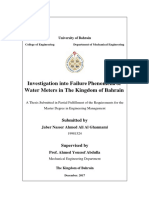Professional Documents
Culture Documents
The Diagnostic Role of Ultrasound and MRI With IHC in A Rare Case of Epithelioid Hemangioendothelioma of Soft Tissue and Management
Original Title
Copyright
Available Formats
Share this document
Did you find this document useful?
Is this content inappropriate?
Report this DocumentCopyright:
Available Formats
The Diagnostic Role of Ultrasound and MRI With IHC in A Rare Case of Epithelioid Hemangioendothelioma of Soft Tissue and Management
Copyright:
Available Formats
Volume 5, Issue 10, October – 2020 International Journal of Innovative Science and Research Technology
ISSN No:-2456-2165
The Diagnostic Role of Ultrasound and
MRI with IHC in a Rare Case of Epithelioid
Hemangioendothelioma of Soft
Tissue and Management
Dr. Divya Y G¹, Dr. Vivek Chail²
¹Post- Graduate, Department of Radio- Diagnosis, Dr. B. R. Ambedkar Medical College, Bangalore – 560045, India.
²Assistant Professor, Department of Radio-Diagnosis, Dr. B. R. Ambedkar Medical College, Bangalore – 560045, India.
Abstract:- Epithelioid Hemangioendothelioma (EH) is a Keywords:- CT Computed Tomography, Epithelioid
rare malignant vascular tumour that is considered to be Hemangioendothelioma, Immunohistochemistry, Magnetic
intermediate grade between benign Hemangioma and Resonance Imaging, Out Patient Department, T1 Weighted
malignant Angiosarcoma originates from vascular Images, T2 Weighted Images, Ultrasound.
endothelial or Pre endothelial cells. EH can occur
anywhere in the body most commonly affects the Liver, I. INTRODUCTION
Lungs, Bones, and although involves the Pleura,
Mediastinum, Spleen, Skin, Breast, Head and neck area, The term "EH" was proposed by Weiss and Enzinger,
Brain and Meninges and Lymph nodes. It often involves to explain a category ofsoft tissue vascular tumours
either superficial or deep soft tissue, visceral organs and composed of epithelioid appearance endothelial cells with
less commonly, medium-size or large veins. The aetiology intermediate clinical course between benign hemangioma
is unknown and is usually diagnosed at young adult, and malignant angiosarcoma[1].
being rare in children. EH is locally aggressive,
heterogenous and represents less than 1% of all the EH, which is a rare vascular tumour with an epithelioid
vascular tumours and capable of metastasis. Prevalence and histiocytoid appearance, originating from vascular
is 1 in 1 million. endothelial or pre-endothelial cells[2].
A 45Years old male presented with soft to firm It has a prevalence of 1 in a million . It is often
subcutaneous swelling since 7years later it progressed misdiagnosed and not suitably treated leading to a poor
rapidly in size from 1year in the Right upper anterior prognosis in many cases[6]. It usually affects middle-aged
chest. On examination: A non-tender, multilobulated patients, although cases in children and elderly people.
exophytic lesion in the subcutaneous plane showing few
erythematous nodules of varying size and were firm in Moreover, many patients are asymptomatic at the time
consistency. High frequency Ultrasound.(US) of Right of diagnosis[4].
Supraclavicular Mass, and MRI Thorax modalities
suggest features of Supraclavicular soft tissue neoplasm The aetiology of EH remains a dilemma. At the
showing vascular components and concern for molecular level, various angiogenic stimulators may act as
Hemangioendothelioma. promoters of endothelial cell proliferation. Recently it had
been reported that monocyte chemo-attractant protein-1 is
Management includes wide excision of the soft required for EH proliferation and might promote the event of
tissue lesion in the supraclavicular region and followed those lesions by stimulating the angiogenic behaviour of
by excisional biopsy and histopathological confirmation. endothelial cells[3].
US and most sensitiveMagnetic Resonance
Imaging(MRI) modality features along with It occurs in any a region of the body are often affected,
pathological techniques of Histopathology and but the foremost common sites are liver alone 21%, liver
Immunohistochemistry(IHC) techniques confirms the plus lungs 18%, lungs alone 12%, and bone alone 14%[5]
vascular nature of tumour. Followed by the wide excision but the prognosis on visceral organs EH is worse.
the patient has undergone adjuvant radiation therapy to
decrease the risk of local recurrence and distant The definitive diagnosis of EH requires
metastasis. Histopathological correlation. The pattern of solid growth
and thus the epithelioid appearance of the endothelium
frequently leads to the mistaken diagnosis of metastatic
carcinoma. The tumour are often distinguished from a
carcinoma by the shortage of pleomorphism and mitotic
IJISRT20OCT360 www.ijisrt.com 543
Volume 5, Issue 10, October – 2020 International Journal of Innovative Science and Research Technology
ISSN No:-2456-2165
activity in most instances and by the presence of focal
vascular channels[1].
II. CASE PRESENTATION
2.1 Clinical History
A 45year old male presented to Surgery OPD, with
soft to firm subcutaneous swelling since 7years later it
progressed rapidly in size from 1year in the right upper
anterior chest with no history of pain.
On physical examination showed non-tender, multilobulated
exophytic lesion in the subcutaneous plane showed
erythematous nodules of varying size and were firm in (b)
consistency(Fig. 1). Cutaneous changes over the lesion Fig. 2 (a) and (b) Grey scale Ultrasound images showing
noted. lobulated soft tissue mass anteriorly to and about the right
clavicle.
2.3 On Colour doppler, lesion was hypervascular showed
low resistance flow in the arteries. Veins showed normal
flows. No admixture flow are seen in Fig. 3.US revealed the
features of differentials of Hemangioendothelioma or Soft
tissue Sarcoma, however in view of lack of infiltration of
underlying muscle planes,Sarcoma was unlikely. However
there was no admixture flow hence angiosarcoma was ruled
out.
Fig. 1:Multilobulated exophytic lesion in the subcutaneous
plane of Right Supraclavicular region.
2.2 On High frequency Ultrasound of Right
Supraclavicular Region showed well defined Lobulated
nodular heterogenous predominantly hypoechoic
subcutaneous soft tissue mass noted anteriorly to and about
the right clavicle extending to the skin surface measures
about 7.6x5.9x6.6cm(Fig. 2).There was no evidence of
infiltration of the lesion into the underlying pectoral
muscles. (a)
(a) (b)
IJISRT20OCT360 www.ijisrt.com 544
Volume 5, Issue 10, October – 2020 International Journal of Innovative Science and Research Technology
ISSN No:-2456-2165
(c)
Fig. 3(a), (b) and (c): Colour Doppler images of Right (b)
Supraclavicular mass showing hypervascular lesion with no Fig. 5: MRI THORAX showing (a) Hypointense lesion on
admixture flow.
T1 WI and (b) Hyperintense on T2 WI with no extension
into the underlying structures clavicle and pectoralis major
2.4 On Computed Tomography(CT) Thorax(Plain) muscle.
showed well defined soft tissue attenuated lesion was seen in
Fig. 4 involving the right supraclavicular region extending to
On Post-contrast T1WI the lesion showed “Target
the skin surface. No evidence of calcification within the Pattern” of hypointense centrally with thick enhancing inner
lesion. peripheral rim and thin non enhancing outer peripheral
rim(Fig.6).
Tubular like hypointense are noted within the lesion on
Post Contrast T1WI suggestive of Intratumoral flow voids
(Fig.6).
Fig. 4 : CT Thorax showing no calcification within the
lesion.
2.5 On MRI Thorax with Contrast
On T1 Weighted Images(T1WI) the lesion was seen in
Fig. 5(a) a large well defined multilobulated Hypointense to
the muscle and in Fig. 5(b) on T2 Weighted Images(T2WI)
there was central hyperintense with peripheral thin (a) (b)
hypointense rim measures 66 x 63 x 77mm (AP x TR x CC)
which was anteriorly extending into the skin surface and
posteriorly lies anterosuperior to the underlying pectoralis
major muscle and medial one third of the clavicle.
(c) (d)
Fig. 6(a), (b), (c) and (d) : MRI THORAX of Axial and
Sagittal sections of Post-contrast T1 Weighted Images
showing Non homogenous enhancement, “Target Pattern” of
hypointense centrally with thick enhancing inner peripheral
rim and thin non enhancing outer peripheral rim with
(a) intratumoral flow voids.
IJISRT20OCT360 www.ijisrt.com 545
Volume 5, Issue 10, October – 2020 International Journal of Innovative Science and Research Technology
ISSN No:-2456-2165
No evidence of extension of lesion into the underlying
structures clavicle and pectoralis major muscle. Lung
parenchyma appeared normal without mass lesion or
infiltration. There was no mediastinal mass and mediastinal
or hilar lymphadenopathy.
2.6 Histopathological findings:
After wide excision of a tumour the sample sent to the
HPE which showed the deep dermis were comprised of
epithelial and endothelial cells arranged in cords and small
nest pattern. Individual tumour cells shows abundant
eosinophilic cytoplasm with some intracytoplasmic (c)
vacuolesFig. 7. All margins of the excised lesion was free Fig. 9(a), (b) and (c) : Immunohistochemical staining shows
from tumour deposits. The features were suggestive of EH tumour cells express CD31, CD34 and ERG.
of Anterior Chest wall.
After the 2 weeks of wide excision of the
supraclavicular soft tissue the patient was referred to the
radiotherapy unit and advised to take the local radiotherapy
to reduce the risk of local recurrence after the primary
surgery and the patient underwent the PET CT scan in which
there was no uptake of FDG in the previously operated right
supraclavicular region, suggestive of no residual tumour
with no distant metastasis. Then Patient underwent the
adjuvant radiation therapy to decrease the risk of local
recurrence.
III. DISCUSSION
(a) (b)
EH may be a rare vascular tumour with an
epithelioid and histiocytoid appearance, originating from
vascular endothelial or pre-endothelial cells[2].
Epithelioid hemangioendothelioma of soft tissue is most
often a solitary lesion, in either the superficial or deep
tissue with uncertain behaviour and prognosis.
The tumour impacts on both sexes equally and no
predisposing factors are recognized. The neoplasm
usually presents as solitary, rarely multiple, slightly
painful erythematous papules, nodules, plaque and
(c) nonhealing ulcer[7].
Fig. 7(a), (b) and (c): Histopathological slides of the
obtained tissue from the wide excision of lesion. Although epithelioid hemangioendothelioma is
capable of causing regional and distant metastasis, it
2.7 IHC : The cells were immunoreactive for CD31, CD34 does thus far less frequently than the typical
endothelial markers and ERG revealed the endothelial nature angiosarcoma. In a recent study the rate of metastases in
of the cells(Fig. 8). epithelioid hemangioendothelioma is found to be
22%[8].
Because of its rarity, EH has no standard treatment.
The available treatment options are surgical resection,
adjuvant chemotherapy and/or radiotherapy[8],[9].
Histopathological examination remains the mainstay of
diagnosis for this rare tumour. The final diagnosis to be
assisted by the use of immunocytochemical techniques.
The more commonly used antisera are CD 31, CD34,
ERG and factor VIII-related antigen. Radiotherapy after
surgical resection is chosen for localized EH to control
residual disease[8],[9].
(a) (b)
IJISRT20OCT360 www.ijisrt.com 546
Volume 5, Issue 10, October – 2020 International Journal of Innovative Science and Research Technology
ISSN No:-2456-2165
The prognosis of EH is uncertain as the mortality and Immunohistochemistry and to arrive at a confirmation
rate for EH of the liver is 35% and lung is 65%. It would of diagnosis followed which patient underwent the wide
seem that the prognosis in primary cutaneous lesions excision with adjuvant radiation therapy to decrease the risk
may be good[7]. of local recurrence and distant metastasis.
In diagnosing the tumour in this case, ultrasonography REFERENCES
demonstrates tumour characterisation and vascularity which
helps in making differential diagnosis. [1]. Weiss SW, Enzinger FM et al;. Epithelioid
Hemangioendothelioma / Soft tissue hemangioendothelioma: a vascular tumor often
Sarcoma/Angiosarcoma, however in view of lack of mistaken for a carcinoma. Cancer 1982;50:970-81.
infiltration of underlying muscle planes, Sarcoma is [2]. Angela Sardaro, Lilia Bardoscia, Maria Fonte
unlikely. There was no admixture flow oncolour doppler, Petruzzelli, and Maurizio Portaluri et al; Epithelioid
Angiosarcoma had been ruled out. Suggest features of Hemangioendothelioma: An Overview and Update on
Supraclavicular soft tissue neoplasm showing vascular a Rare Vascular Tumor 2014 Sep 23; 8(2): 259.
components and concern for Hemangioendothelioma. [3]. Gordillo GM, Onat D, Stockinger M, et al. A key
Magnetic Resonance Imaging(MRI) Thorax of contrast angiogenic role of monocyte chemoattractant protein-1
modality has major role in diagnosing epithelioid in hemangioendothelioma proliferation. Am J Physiol
hemangioendothelioma showing the characteristic Target Cell Physiol 2004;4:C866-73.
pattern of the lesion with minimal delayed capsule [4]. A. LlodioUribeetxebarria, A. Carballeira Álvarez, S.
enhancement and intralesional flow voids. Correa García, M. Esnaola Albizu, J. Vega Eraso, K.
BiurrunMancisidor; Donostia/ES et al; Epithelioid
However CT Thorax is done as the ancillary to the hemangioendothelioma: a diagnostic challenge CT and
MRI has the MRI is most sensitive modality to evaluate the MRI appearance: from typical to bizarre.
soft tissue structures and the soft tissue lesions to delineate [5]. Lau K, Massad M, Pollak C, Rubin C, Yeh J, Wang J,
its characteristics by the extent of the lesion and its et al. Clinical patterns and outcome in epithelioid
relationship to the adjacent structures and provides an hemangioendothelioma with or without pulmonary
excellent contrast resolution. involvement: Insights from an internet registry in the
study of a rare cancer. Chest 2011;140:1312-8.
The patient underwent the wide excision of the right [6]. Friday Titus Nyaku1, Theophilus Maksha Dabkana1,
supraclavicular lesion with skin grafting and the sample sent Haruna A Nggada2, Joasaih Miner Njem3, Stanley
to the HPE showing deep dermis are comprised of epithelial Tella Bwala1, Yakubu Mohammed Gana1, et al
and endothelial cells with abundant eosinophilic cytoplasm Epithelioid haemengioendothelioma: A report of two
with some intracytoplasmic vacuoles consistent with cases 2019.
Epithelioid Hemangioendothelioma and was confirmed by [7]. Enzinger FM, Weiss SW., et al
IHC in which tumour cells were immunoreactive for CD31, Hemangioendothelioma: Vascular tumors of
CD34 endothelial markers and ERG, revealed the intermediate malignancy. In: Enzinger FM, Weiss SW,
endothelial nature of the cells. editors. Soft tissue tumors. 3 rd ed. St. Louis: CV
Mosby 1995. p. 627-31.
Wide excision of the supraclavicular soft tissue was [8]. Deyrup AT, Tighiouart M, Montag AG, Weiss SW, et
done and after 2 weeks the patient was referred to the al Epithelioid haemangioendothelioma of soft tissue: A
radiotherapy unit and advised to take the local radiotherapy proposal for risk stratification based on 49 cases. Am J
to reduce the risk of local recurrence after the primary SurgPathol 2008;32:924-7.
surgery and the patient underwent the PET CT scan in which [9]. Mascarelli PE, Iredell JR, Maggi RG, Weinberg G,
there was no uptake of FDG in the previously operated right Breitschwerdt EB, et alBartonella species bacteremia
supraclavicular region suggestive of no residual tumour with in two patients with epithelioid
no distant metastasis. Then Patient underwent the adjuvant hemangioendothelioma. J Clin Microbiol
radiation therapy to decrease the risk of local recurrence. 2011;49:4006-12.
[10]. Gaur S, Torabi A, O'Neill TJ, et al Activity of
IV. CONCLUSION angiogenesis inhibitors in metastatic epithelioid
hemangioendothelioma: A case report. Cancer Biol
The importance of distinguishing epithelioid vascular Med 2012;9:133-6.
tumor on suspecting malignant epithelioid vascular tumor on [11]. Sumana Mukherjee, Jayati Mallick, Prabir C Pal,
imaging and further characterization into subgroups, using Sarbani Chattopadhyay, et al Hemangioendothelioma
Ultrasound and most sensitive MRI modality features are of soft tissue: Cytological dilemma in two cases at
confirmed with pathological techniques of Histopathology unusual sites 2012;29;89-91.
IJISRT20OCT360 www.ijisrt.com 547
You might also like
- The Subtle Art of Not Giving a F*ck: A Counterintuitive Approach to Living a Good LifeFrom EverandThe Subtle Art of Not Giving a F*ck: A Counterintuitive Approach to Living a Good LifeRating: 4 out of 5 stars4/5 (5794)
- The Gifts of Imperfection: Let Go of Who You Think You're Supposed to Be and Embrace Who You AreFrom EverandThe Gifts of Imperfection: Let Go of Who You Think You're Supposed to Be and Embrace Who You AreRating: 4 out of 5 stars4/5 (1090)
- Never Split the Difference: Negotiating As If Your Life Depended On ItFrom EverandNever Split the Difference: Negotiating As If Your Life Depended On ItRating: 4.5 out of 5 stars4.5/5 (838)
- Hidden Figures: The American Dream and the Untold Story of the Black Women Mathematicians Who Helped Win the Space RaceFrom EverandHidden Figures: The American Dream and the Untold Story of the Black Women Mathematicians Who Helped Win the Space RaceRating: 4 out of 5 stars4/5 (895)
- Grit: The Power of Passion and PerseveranceFrom EverandGrit: The Power of Passion and PerseveranceRating: 4 out of 5 stars4/5 (588)
- Shoe Dog: A Memoir by the Creator of NikeFrom EverandShoe Dog: A Memoir by the Creator of NikeRating: 4.5 out of 5 stars4.5/5 (537)
- The Hard Thing About Hard Things: Building a Business When There Are No Easy AnswersFrom EverandThe Hard Thing About Hard Things: Building a Business When There Are No Easy AnswersRating: 4.5 out of 5 stars4.5/5 (344)
- Elon Musk: Tesla, SpaceX, and the Quest for a Fantastic FutureFrom EverandElon Musk: Tesla, SpaceX, and the Quest for a Fantastic FutureRating: 4.5 out of 5 stars4.5/5 (474)
- Her Body and Other Parties: StoriesFrom EverandHer Body and Other Parties: StoriesRating: 4 out of 5 stars4/5 (821)
- The Sympathizer: A Novel (Pulitzer Prize for Fiction)From EverandThe Sympathizer: A Novel (Pulitzer Prize for Fiction)Rating: 4.5 out of 5 stars4.5/5 (119)
- The Emperor of All Maladies: A Biography of CancerFrom EverandThe Emperor of All Maladies: A Biography of CancerRating: 4.5 out of 5 stars4.5/5 (271)
- The Little Book of Hygge: Danish Secrets to Happy LivingFrom EverandThe Little Book of Hygge: Danish Secrets to Happy LivingRating: 3.5 out of 5 stars3.5/5 (399)
- The World Is Flat 3.0: A Brief History of the Twenty-first CenturyFrom EverandThe World Is Flat 3.0: A Brief History of the Twenty-first CenturyRating: 3.5 out of 5 stars3.5/5 (2219)
- The Yellow House: A Memoir (2019 National Book Award Winner)From EverandThe Yellow House: A Memoir (2019 National Book Award Winner)Rating: 4 out of 5 stars4/5 (98)
- Devil in the Grove: Thurgood Marshall, the Groveland Boys, and the Dawn of a New AmericaFrom EverandDevil in the Grove: Thurgood Marshall, the Groveland Boys, and the Dawn of a New AmericaRating: 4.5 out of 5 stars4.5/5 (266)
- A Heartbreaking Work Of Staggering Genius: A Memoir Based on a True StoryFrom EverandA Heartbreaking Work Of Staggering Genius: A Memoir Based on a True StoryRating: 3.5 out of 5 stars3.5/5 (231)
- Team of Rivals: The Political Genius of Abraham LincolnFrom EverandTeam of Rivals: The Political Genius of Abraham LincolnRating: 4.5 out of 5 stars4.5/5 (234)
- On Fire: The (Burning) Case for a Green New DealFrom EverandOn Fire: The (Burning) Case for a Green New DealRating: 4 out of 5 stars4/5 (73)
- The Unwinding: An Inner History of the New AmericaFrom EverandThe Unwinding: An Inner History of the New AmericaRating: 4 out of 5 stars4/5 (45)
- AnalogyDocument50 pagesAnalogyNathaniel Campeciño89% (9)
- Emerald Emerging Markets Case Studies: Article InformationDocument25 pagesEmerald Emerging Markets Case Studies: Article InformationHannah CastroNo ratings yet
- Indikasi, Teknik Pembuatan Stoma, ReanastomosispptDocument43 pagesIndikasi, Teknik Pembuatan Stoma, ReanastomosispptErwin Aritama Ismail100% (1)
- Historical CriticismDocument1 pageHistorical CriticismPatricia Ann Dulce Ambata67% (3)
- Arvydas Sliogeris The Thing and Art Two Essays On The Ontotopy of The Work of Art 1Document168 pagesArvydas Sliogeris The Thing and Art Two Essays On The Ontotopy of The Work of Art 1Richard OhNo ratings yet
- Sell More, Serve BetterDocument39 pagesSell More, Serve BetterSalesMantra CRM100% (4)
- Parastomal Hernia: A Case Report, Repaired by Modified Laparascopic Sugarbaker TechniqueDocument2 pagesParastomal Hernia: A Case Report, Repaired by Modified Laparascopic Sugarbaker TechniqueInternational Journal of Innovative Science and Research TechnologyNo ratings yet
- Smart Health Care SystemDocument8 pagesSmart Health Care SystemInternational Journal of Innovative Science and Research TechnologyNo ratings yet
- Visual Water: An Integration of App and Web to Understand Chemical ElementsDocument5 pagesVisual Water: An Integration of App and Web to Understand Chemical ElementsInternational Journal of Innovative Science and Research TechnologyNo ratings yet
- Air Quality Index Prediction using Bi-LSTMDocument8 pagesAir Quality Index Prediction using Bi-LSTMInternational Journal of Innovative Science and Research TechnologyNo ratings yet
- Smart Cities: Boosting Economic Growth through Innovation and EfficiencyDocument19 pagesSmart Cities: Boosting Economic Growth through Innovation and EfficiencyInternational Journal of Innovative Science and Research TechnologyNo ratings yet
- Parkinson’s Detection Using Voice Features and Spiral DrawingsDocument5 pagesParkinson’s Detection Using Voice Features and Spiral DrawingsInternational Journal of Innovative Science and Research TechnologyNo ratings yet
- Predict the Heart Attack Possibilities Using Machine LearningDocument2 pagesPredict the Heart Attack Possibilities Using Machine LearningInternational Journal of Innovative Science and Research TechnologyNo ratings yet
- Impact of Silver Nanoparticles Infused in Blood in a Stenosed Artery under the Effect of Magnetic Field Imp. of Silver Nano. Inf. in Blood in a Sten. Art. Under the Eff. of Mag. FieldDocument6 pagesImpact of Silver Nanoparticles Infused in Blood in a Stenosed Artery under the Effect of Magnetic Field Imp. of Silver Nano. Inf. in Blood in a Sten. Art. Under the Eff. of Mag. FieldInternational Journal of Innovative Science and Research TechnologyNo ratings yet
- An Analysis on Mental Health Issues among IndividualsDocument6 pagesAn Analysis on Mental Health Issues among IndividualsInternational Journal of Innovative Science and Research TechnologyNo ratings yet
- Compact and Wearable Ventilator System for Enhanced Patient CareDocument4 pagesCompact and Wearable Ventilator System for Enhanced Patient CareInternational Journal of Innovative Science and Research TechnologyNo ratings yet
- Implications of Adnexal Invasions in Primary Extramammary Paget’s Disease: A Systematic ReviewDocument6 pagesImplications of Adnexal Invasions in Primary Extramammary Paget’s Disease: A Systematic ReviewInternational Journal of Innovative Science and Research TechnologyNo ratings yet
- Terracing as an Old-Style Scheme of Soil Water Preservation in Djingliya-Mandara Mountains- CameroonDocument14 pagesTerracing as an Old-Style Scheme of Soil Water Preservation in Djingliya-Mandara Mountains- CameroonInternational Journal of Innovative Science and Research TechnologyNo ratings yet
- Exploring the Molecular Docking Interactions between the Polyherbal Formulation Ibadhychooranam and Human Aldose Reductase Enzyme as a Novel Approach for Investigating its Potential Efficacy in Management of CataractDocument7 pagesExploring the Molecular Docking Interactions between the Polyherbal Formulation Ibadhychooranam and Human Aldose Reductase Enzyme as a Novel Approach for Investigating its Potential Efficacy in Management of CataractInternational Journal of Innovative Science and Research TechnologyNo ratings yet
- Insights into Nipah Virus: A Review of Epidemiology, Pathogenesis, and Therapeutic AdvancesDocument8 pagesInsights into Nipah Virus: A Review of Epidemiology, Pathogenesis, and Therapeutic AdvancesInternational Journal of Innovative Science and Research TechnologyNo ratings yet
- Harnessing Open Innovation for Translating Global Languages into Indian LanuagesDocument7 pagesHarnessing Open Innovation for Translating Global Languages into Indian LanuagesInternational Journal of Innovative Science and Research TechnologyNo ratings yet
- The Relationship between Teacher Reflective Practice and Students Engagement in the Public Elementary SchoolDocument31 pagesThe Relationship between Teacher Reflective Practice and Students Engagement in the Public Elementary SchoolInternational Journal of Innovative Science and Research TechnologyNo ratings yet
- Investigating Factors Influencing Employee Absenteeism: A Case Study of Secondary Schools in MuscatDocument16 pagesInvestigating Factors Influencing Employee Absenteeism: A Case Study of Secondary Schools in MuscatInternational Journal of Innovative Science and Research TechnologyNo ratings yet
- Dense Wavelength Division Multiplexing (DWDM) in IT Networks: A Leap Beyond Synchronous Digital Hierarchy (SDH)Document2 pagesDense Wavelength Division Multiplexing (DWDM) in IT Networks: A Leap Beyond Synchronous Digital Hierarchy (SDH)International Journal of Innovative Science and Research TechnologyNo ratings yet
- Diabetic Retinopathy Stage Detection Using CNN and Inception V3Document9 pagesDiabetic Retinopathy Stage Detection Using CNN and Inception V3International Journal of Innovative Science and Research TechnologyNo ratings yet
- Advancing Healthcare Predictions: Harnessing Machine Learning for Accurate Health Index PrognosisDocument8 pagesAdvancing Healthcare Predictions: Harnessing Machine Learning for Accurate Health Index PrognosisInternational Journal of Innovative Science and Research TechnologyNo ratings yet
- Auto Encoder Driven Hybrid Pipelines for Image Deblurring using NAFNETDocument6 pagesAuto Encoder Driven Hybrid Pipelines for Image Deblurring using NAFNETInternational Journal of Innovative Science and Research TechnologyNo ratings yet
- Formulation and Evaluation of Poly Herbal Body ScrubDocument6 pagesFormulation and Evaluation of Poly Herbal Body ScrubInternational Journal of Innovative Science and Research TechnologyNo ratings yet
- The Utilization of Date Palm (Phoenix dactylifera) Leaf Fiber as a Main Component in Making an Improvised Water FilterDocument11 pagesThe Utilization of Date Palm (Phoenix dactylifera) Leaf Fiber as a Main Component in Making an Improvised Water FilterInternational Journal of Innovative Science and Research TechnologyNo ratings yet
- The Making of Object Recognition Eyeglasses for the Visually Impaired using Image AIDocument6 pagesThe Making of Object Recognition Eyeglasses for the Visually Impaired using Image AIInternational Journal of Innovative Science and Research TechnologyNo ratings yet
- The Impact of Digital Marketing Dimensions on Customer SatisfactionDocument6 pagesThe Impact of Digital Marketing Dimensions on Customer SatisfactionInternational Journal of Innovative Science and Research TechnologyNo ratings yet
- Electro-Optics Properties of Intact Cocoa Beans based on Near Infrared TechnologyDocument7 pagesElectro-Optics Properties of Intact Cocoa Beans based on Near Infrared TechnologyInternational Journal of Innovative Science and Research TechnologyNo ratings yet
- A Survey of the Plastic Waste used in Paving BlocksDocument4 pagesA Survey of the Plastic Waste used in Paving BlocksInternational Journal of Innovative Science and Research TechnologyNo ratings yet
- Cyberbullying: Legal and Ethical Implications, Challenges and Opportunities for Policy DevelopmentDocument7 pagesCyberbullying: Legal and Ethical Implications, Challenges and Opportunities for Policy DevelopmentInternational Journal of Innovative Science and Research TechnologyNo ratings yet
- Comparatively Design and Analyze Elevated Rectangular Water Reservoir with and without Bracing for Different Stagging HeightDocument4 pagesComparatively Design and Analyze Elevated Rectangular Water Reservoir with and without Bracing for Different Stagging HeightInternational Journal of Innovative Science and Research TechnologyNo ratings yet
- Design, Development and Evaluation of Methi-Shikakai Herbal ShampooDocument8 pagesDesign, Development and Evaluation of Methi-Shikakai Herbal ShampooInternational Journal of Innovative Science and Research Technology100% (3)
- Birla Sun Life Implements Talisma CRMDocument10 pagesBirla Sun Life Implements Talisma CRMvishuvamNo ratings yet
- JurnalDocument10 pagesJurnalIca PurnamasariNo ratings yet
- A Series of Standalone Products: Communication SDK ManualDocument99 pagesA Series of Standalone Products: Communication SDK ManualniksickopivoNo ratings yet
- Primary Year 3 SJK SOWDocument150 pagesPrimary Year 3 SJK SOWJoshua100% (1)
- SPELLFIRE - Sets Oficiais - XLSX Versão 1Document88 pagesSPELLFIRE - Sets Oficiais - XLSX Versão 1Valdir BarbosaNo ratings yet
- Religion ScriptDocument3 pagesReligion Scriptapi-461590822No ratings yet
- Workbook Answer Key SEODocument2 pagesWorkbook Answer Key SEOlabNo ratings yet
- English Revision Notes XIIDocument41 pagesEnglish Revision Notes XIIRämíz MêmóñNo ratings yet
- Investigation Into Failure Phenomena of Water Meter in The Kingdom of BahrainDocument118 pagesInvestigation Into Failure Phenomena of Water Meter in The Kingdom of BahrainJabnon NonjabNo ratings yet
- Demo TeachingDocument27 pagesDemo TeachingVince BulayogNo ratings yet
- Fetal Mummification in CowsDocument22 pagesFetal Mummification in CowsTahseen AlamNo ratings yet
- Hospital Ship Feasibility StudyDocument10 pagesHospital Ship Feasibility StudyRhona JhoyNo ratings yet
- Chapter 2 Fluid StaticsDocument13 pagesChapter 2 Fluid StaticsguhanNo ratings yet
- dll-4th QTR.-MUSIC-MAY-3-4-2023Document5 pagesdll-4th QTR.-MUSIC-MAY-3-4-2023Dennis MartinezNo ratings yet
- Tle Fos 9 11 q1 WK 7 d1Document6 pagesTle Fos 9 11 q1 WK 7 d1REYMOND SUMAYLONo ratings yet
- PDF Microsite Achieve Global AG Survey of Sales EffectivenessDocument44 pagesPDF Microsite Achieve Global AG Survey of Sales Effectivenessingrid_walrabensteinNo ratings yet
- Chapter 8Document3 pagesChapter 8Michelle MartinNo ratings yet
- Bagi Latihan Soal 3Document3 pagesBagi Latihan Soal 3MUH LULU BNo ratings yet
- Tee Cube Collections Catalogue With Google Photos Link PDFDocument4 pagesTee Cube Collections Catalogue With Google Photos Link PDFKirat SinghNo ratings yet
- Notes BST - CH 1Document5 pagesNotes BST - CH 1Khushi KashyapNo ratings yet
- Mod Is A 27112013Document8 pagesMod Is A 27112013Garankuwa HiphopCommiteeNo ratings yet
- Benjamin Joel - American Grandmaster. Four Decades of Chess Adventures, 2007-OCR, Everyman, 270p PDFDocument270 pagesBenjamin Joel - American Grandmaster. Four Decades of Chess Adventures, 2007-OCR, Everyman, 270p PDFGabriel Henrique100% (1)
- Writing An Opinion ParagraphDocument3 pagesWriting An Opinion ParagraphlusianaNo ratings yet
- FSLDMDocument5 pagesFSLDMaiabbasi9615No ratings yet




































































































